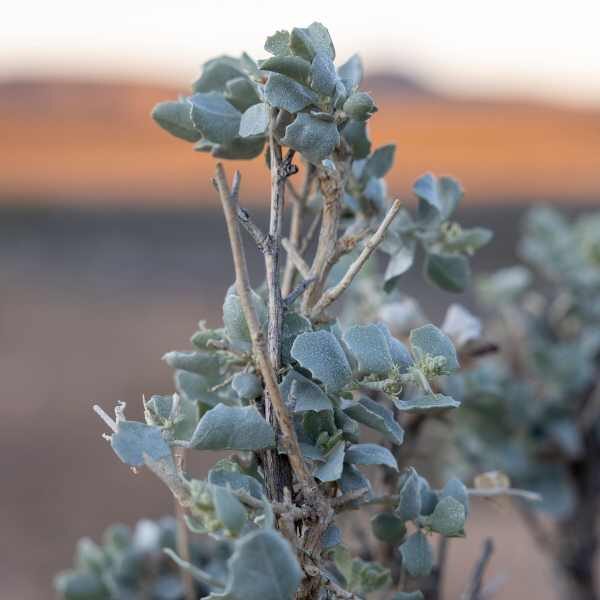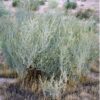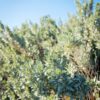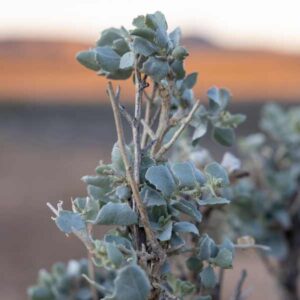Salt Bush
$5.99
Atriplex Nummularia
- Seed Count 100
- Bush Tucker
- Perennial
In stock
Description
Old Man Salt Bush is a familiar sight over large areas of the dry inland of Australia. It is a sprawling grey-blue shrub, up to 3 metres high and sometimes spreading to 5 metres wide.
A long living plant, it grows strongly after periods of summer rain, producing long tassels of flowering seed heads.
It is valued for its ability to thrive in saline and arid conditions, making it an excellent choice for soil rehabilitation, livestock forage, and windbreaks.
Salt bush seeds were ground and roasted for damper but these days we utilise the large fresh or blanched Salt bush leaves as a wrap around meat or fish, in salads or as a leafy bed for grilled meat or vegetables.
Its dried leaves with their unique salty flavour, make a superb crunchy herb sprinkle.
The leaves are also dried for use in bread, as well as low sodium seasoning on grills, pasta and dukkah and they can be harvested year round.
The plants can an be kept small and grown in pots if harvested regularly and with regular pruning they make a great gap filler or edible hedge.
Seed Preparation
Seed Treatment:
- Salt Bush seeds have a natural dormancy mechanism.
- To improve germination, soak your seeds in water for 12-24 hours to soften the seed coat.
- Alternatively, scarify the seeds lightly by rubbing them with sandpaper or nicking the seed coat with a knife.
Soil Requirements
Soil Type:
- Salt Bush thrives in well-draining soils, including sandy, loamy, or clay soils.
Soil pH:
- Tolerates a wide pH range (6.0–8.5) but prefers slightly alkaline conditions.
Salinity Tolerance:
- Highly salt-tolerant, making it suitable for saline or degraded soils.
Soil Preparation:
- Loosen the soil to a depth of 15–20 cm and remove weeds or debris. Incorporate organic matter if the soil is poor.
Sowing Seeds
Timing:
- Sow seeds in spring or early summer when soil temperatures are consistently above 15°C.
Method:
- Direct Sowing: Scatter seeds evenly over the prepared soil and lightly cover with 5 mm of soil.
Seed Trays:
- For better control, sow seeds in seed trays filled with a well-draining seed-raising mix for natives.
- Transplant seedlings when they are 5–10 cm tall.
Spacing:
- Space seeds or seedlings 1–2 meters apart to allow for mature growth.
Watering
- Germination Phase: Keep the soil moist but not waterlogged during germination (2–4 weeks).
- Establishment Phase: Water seedlings regularly for the first 6–12 months until they are well-established.
- Mature Plants: Once established, Salt Bush is highly drought tolerant and requires minimal watering.
Light and Temperature
Light:
- Requires full sun for optimal growth.
Temperature:
- Thrives in warm climates and can tolerate temperatures up to 40°C.
- Frost tolerant once established.
Fertilisation
- Nutrient Requirements: Salt Bush is adapted to low-fertility soils and generally does not require fertilisation.
- If growth is slow, apply a balanced, slow-release fertiliser during the establishment phase.
Maintenance
Weeding: Keep the area around young plants weed free to reduce competition for nutrients and water.
Pruning:
- Prune lightly to maintain shape and encourage bushy growth.
- Pruning is not essential but can improve forage quality for livestock.
Pests and Diseases:
- Generally, pest resistant.
- Monitor for aphids or scale insects and treat with organic insecticides if necessary.
Harvesting and Uses
Forage:
- Leaves and stems can be harvested for livestock feed. Regular pruning promotes new growth.
Soil Rehabilitation:
- Plant in degraded or saline areas to improve soil structure and reduce erosion.
Windbreaks:
- Use as a windbreak or shelterbelt in arid regions.
Key Tips for Success
- Choose a sunny, well-draining location.
- Pretreat seeds to improve germination rates.
- Water regularly during establishment but avoid overwatering.
Postage Charge
Orders under $30 attract a $4.50 shipping charge. Orders $30 and above have free shipping.
Order Times
Seed orders are normally dispatched within three business days. You will receive an email when seeds are mailed out.
Postage Days
Seeds are mailed out Monday to Friday at 1pm. Except for the Friday of long weekends.
Postage Times
WA 2-3 Days: SA,NT 3-5 Days: NSW, ACT, QLD, VIC: 5-7 Days
Carrier
We use Australia Post Letter Postage for the majority of orders
Not only are our seeds packed in recycled paper envelopes, we keep the theme going when we post out website orders. To protect your seeds from moisture and the letter box munchers (snails), we use a very special plastic free material made from plants. They are then put into recycled mailing envelopes. Green all the way 💚🌿












Reviews
There are no reviews yet